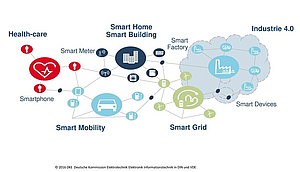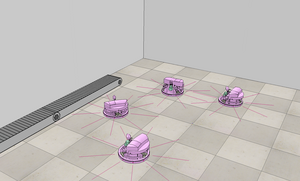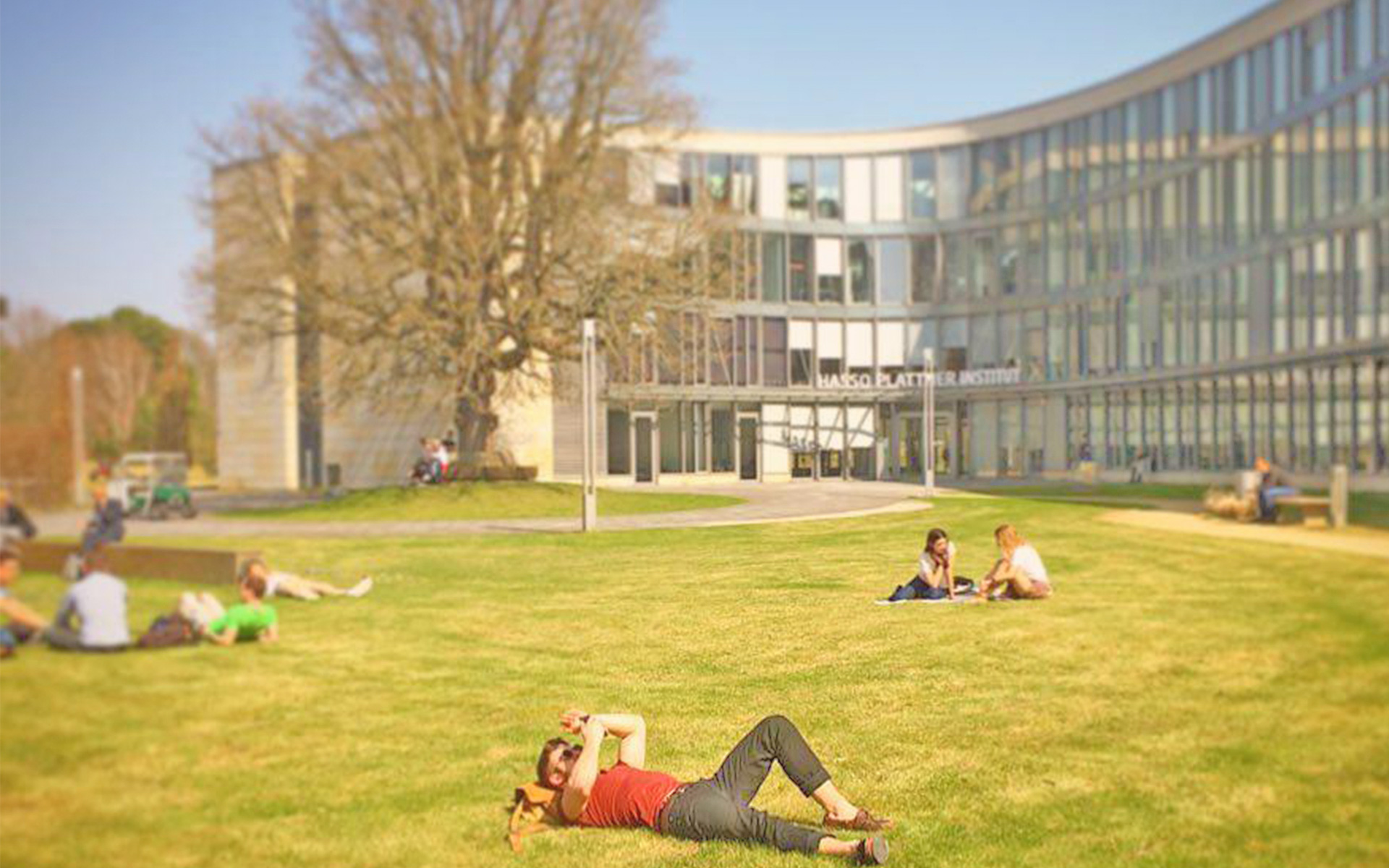Engineering Smart Systems and Service (Sommersemester 2018)
Dozent:
Prof. Dr. Holger Giese
(Systemanalyse und Modellierung)
,
Joachim Hänsel
(Systemanalyse und Modellierung)
Allgemeine Information
- Semesterwochenstunden: 4
- ECTS: 6
- Benotet:
Ja
- Einschreibefrist: 20.04.2018
- Lehrform: Projektseminar
- Belegungsart: Wahlpflichtmodul
Studiengänge, Modulgruppen & Module
- IT-Systems Engineering
- IT-Systems Engineering
- IT-Systems Engineering
- IT-Systems Engineering
- SAMT: Software Architecture & Modeling Technology
- HPI-SAMT-K Konzepte und Methoden
- SAMT: Software Architecture & Modeling Technology
- HPI-SAMT-S Spezialisierung
- SAMT: Software Architecture & Modeling Technology
- HPI-SAMT-T Techniken und Werkzeuge
Beschreibung
Smart Systems are systems that support a combination of data processing, sensing, actuating and communication. These abilities allow for complex situation analysis and autonomous decisions making while remaining invisible to the consumer. Furthermore Smart Systems are often able to recognise each other and to interact with the environment and with other “intelligent” systems. Their application is expected to lead to systems with, for example, improved safety, reduced emissions or more energy-efficient infrastructure elements. It is expected that their incorporation will be key for the competitiveness of products in many sectors. On a broader spectrum they are also considered to provide solutions to address many grand challenges and risks for mankind in social, economic and environmental terms such as, for example, pollution of the environment, depletion of energy and materials resources, or increased needs for the mobility of people and goods (cf. [13]).
If such smart systems are connected to the cloud, the data they generated can be employed to produce smart services to control, maintain and enhance the offering. For private consumers, a smart service might offer them to employ mobility services online instead of having to purchase and operate their own mobility solution. The technical infrastructure underlying smart services are usually cyber-physical systems. The users who employ services in their respective roles as consumers, employees, citizens, patients and tourists are at the center and can obtain the right combination of products and services to meet their needs according to their current situation, anytime, anywhere (cf. [10]).
For this direction of smart system and services a Plethora of different special cases for particular domains such as smart agriculture, smart bulidings, smart city, smart energy, smart factory, smart home, smart mobility, smart product, smart tag, smart device etc. has been developed.

In this project seminar, we want to address this challenge by discussing the general needs and obtain hands on experience with engineering such systems inside a simulator. As a case study we consider a small smart factory, where smart services allow to optimize the production.

Literatur
[1] Nicola Bombieri, Massimo Poncino, and Graziano Pravadelli. Smart Systems Integration and Simulation. Springer Publishing Company, Incorporated, 1st edition, 2016.
[2] Arndt Borgmeier, Alexander Grohmann, and Stefan F. Gross, editors. Smart Services und Internet der Dinge: Geschäftsmodelle, Umsetzung und Best Practices. Hanser, Munchen, 2017.
[3] Dimitrios Georgakopoulos and Prem Prakash Jayaraman. Internet of things: from internet scale sensing to smart services. Computing, 98(10):1041–1058, 2016.
[4] Holger Giese, Thomas Vogel, and Sebastian Wätzoldt. Towards Smart Systems of Systems. In Mehdi Dastani and Marjan Sirjani, editors, Proceedings of the 6th In¬ternational Conference on Fundamentals of Software Engineering (FSEN ’15), volume 9392 of Lecture Notes in Computer Science (LNCS), pages 1–29. Springer, 2015. (invited paper).
[5] John E. Kelly and Steve Hamm. Smart machines : IBM’s Watson and the era of cognitive computing. Columbia Business School Publishing, 2013.
[6] Salman Ali Khan, Arhsad Farhad, Muham¬mad Ibrar, and Muhammad Arif. Real Time Algorithm for the Smart Home Automation Based on the Internet of Things.
International Journal of Computer Science and Information Security, 14, number 7, july, 2016, pages 94-99.
[7] Mike Kuniavsky. Smart Things: Ubiquitous Computing User Experience Design. Morgan Kaufmann Publishers Inc., San Francisco, CA, USA, 2010.
[8] Eduardo Felipe Zambom Santana, Ana Paula Chaves, Marco Aurelio Gerosa, Fabio Kon, and Dejan S. Milojicic. Software Platforms for Smart Cities: Concepts, Requirements, Challenges, and a Unified Reference Architecture. ACM Comput. Surv., 50(6):78:1–78:37, November 2017.
[9] Natalia Silvis-Cividjian. Pervasive Computing: Engineering Smart Systems. Springer Publishing Company, Incorporated, 1st edition, 2017.
[10] Smart Service Welt. Recommendations for the Strategic Initiative Web-based Services for Businesses. Final Report, March 2015.
[11] Pravin Varaiya. Smart cars on smart roads: problems of control. Automatic Control, IEEE Transactions on, 38(2):195 –207, February 1993.
[12] Carlos Cetina, Pau Giner, Joan Fons, and Vicente Pelechano. Autonomic Computing through Reuse of Variability Models at Runtime: The Case of Smart Homes. Computer, 42(10):37–43, 2009.
[13] Smart Systems in the Multi-Annual Strategic Research and Innovation Agenda of the JTI ECSEL, Part D, EPoSS Industry Association, March 2014
Lern- und Lehrformen
The course is a project seminar, which has an introductory phase comprised by an initial short lecture. After that, students will work together to develop the aforementioned case study.
Leistungserfassung
We will grade the implementation (50%), documentation (40%), and presentations (10%). Participation in the project seminar during meetings and other groups' presentations in the form of questions and feedback will also be required.
Termine
After the introductory phase with an initial short lecture, we will plan and develop the case study. There will be regular feedback meetings for issues concerning the development. In addition, there will also be regular meetings during the semester to present the progress of the development efforts.
The project seminar will be presented at the first meeting on Tuesday 17 of April at 17:00 A-2.1
Zurück

